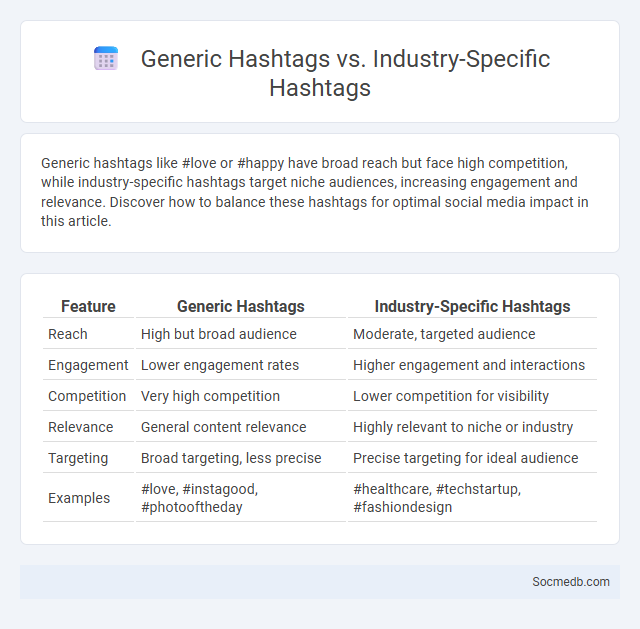
Photo illustration: Generic Hashtags vs Industry-specific Hashtags
Generic hashtags like #love or #happy have broad reach but face high competition, while industry-specific hashtags target niche audiences, increasing engagement and relevance. Discover how to balance these hashtags for optimal social media impact in this article.
Table of Comparison
| Feature | Generic Hashtags | Industry-Specific Hashtags |
|---|---|---|
| Reach | High but broad audience | Moderate, targeted audience |
| Engagement | Lower engagement rates | Higher engagement and interactions |
| Competition | Very high competition | Lower competition for visibility |
| Relevance | General content relevance | Highly relevant to niche or industry |
| Targeting | Broad targeting, less precise | Precise targeting for ideal audience |
| Examples | #love, #instagood, #photooftheday | #healthcare, #techstartup, #fashiondesign |
Introduction to Hashtags: Purpose and Power
Hashtags serve as powerful tools to categorize content and increase its visibility across social media platforms like Instagram, Twitter, and LinkedIn. By using relevant and trending hashtags, you can connect with targeted audiences and enhance engagement rates. Understanding the purpose and strategic use of hashtags elevates your social media presence, driving discoverability and brand growth.
What Are Generic Hashtags?
Generic hashtags are broad, widely used keywords or phrases on social media that categorize content across various topics, such as #love, #travel, or #food. These hashtags increase post visibility by reaching a large and diverse audience but often face high competition, making it harder for individual content to stand out. Effective use of generic hashtags, combined with niche-specific tags, enhances engagement and discovery on platforms like Instagram and Twitter.
Understanding Industry-specific Hashtags
Understanding industry-specific hashtags enhances your social media strategy by increasing content visibility to targeted audiences. Analyzing trending and niche hashtags within your field allows you to connect with relevant communities and boost engagement rates. Using precise hashtags tailored to your industry drives more meaningful interactions and fosters brand authority.
Pros and Cons of Generic Hashtags
Generic hashtags like #love or #instagood can significantly boost your post visibility by reaching a broad and diverse audience across social media platforms. However, these hashtags often suffer from high competition, causing your content to quickly get buried among millions of posts, reducing engagement potential. Balancing generic hashtags with niche-specific ones enhances your reach while targeting your ideal audience more effectively.
Pros and Cons of Industry-specific Hashtags
Industry-specific hashtags enhance your content's visibility by targeting niche audiences and improving engagement rates on platforms like Instagram and Twitter. These hashtags foster community building and enable businesses to track trends and competitor activities more effectively. However, overuse or misuse can limit reach, confuse potential followers, and reduce overall engagement if the tags are too obscure or overly competitive.
How Generic vs Industry-specific Hashtags Impact Reach
Generic hashtags like #love or #food provide broad visibility but often get lost in high-volume searches, limiting targeted engagement, while industry-specific hashtags such as #TechInnovation or #VeganRecipes attract niche audiences highly interested in particular topics, boosting relevant reach and engagement rates. Studies show that posts with sector-tailored hashtags achieve up to 70% higher interaction compared to those using only generic tags. Leveraging a strategic mix of both can optimize content reach by balancing mass exposure with audience specificity.
Crafting an Effective Hashtag Strategy
Crafting an effective hashtag strategy involves researching trending and niche-specific keywords to increase content visibility and engagement on platforms like Instagram, Twitter, and TikTok. Combining broad and targeted hashtags helps reach diverse audiences while analyzing hashtag performance metrics optimizes future campaigns. Consistency in hashtag use across posts strengthens brand recognition and fosters community growth.
Mixing Generic and Niche Hashtags: Best Practices
Mixing generic and niche hashtags enhances your social media reach by targeting both broad and specific audiences. Using popular, generic hashtags boosts visibility, while niche hashtags connect you with highly engaged communities relevant to your content. Strategically balancing these hashtags maximizes engagement and helps your posts appear in diverse search results tailored to Your interests.
Measuring Hashtag Performance and Engagement
Measuring hashtag performance and engagement involves analyzing metrics such as reach, impressions, and user interactions like likes, comments, and shares. Tracking these data points helps you understand your audience's behavior and the effectiveness of your social media campaigns. Utilize analytic tools to monitor hashtag trends and optimize your strategy for maximum visibility and engagement.
Final Thoughts: Choosing the Right Hashtags for Your Brand
Selecting the right hashtags for your brand enhances visibility and targets the desired audience effectively on social media platforms like Instagram, Twitter, and TikTok. Researching trending and niche-specific hashtags, combined with analyzing competitor hashtag strategies, optimizes engagement and campaign reach. Consistent monitoring and updating hashtag strategies based on performance metrics improve brand recognition and foster community growth.
 socmedb.com
socmedb.com